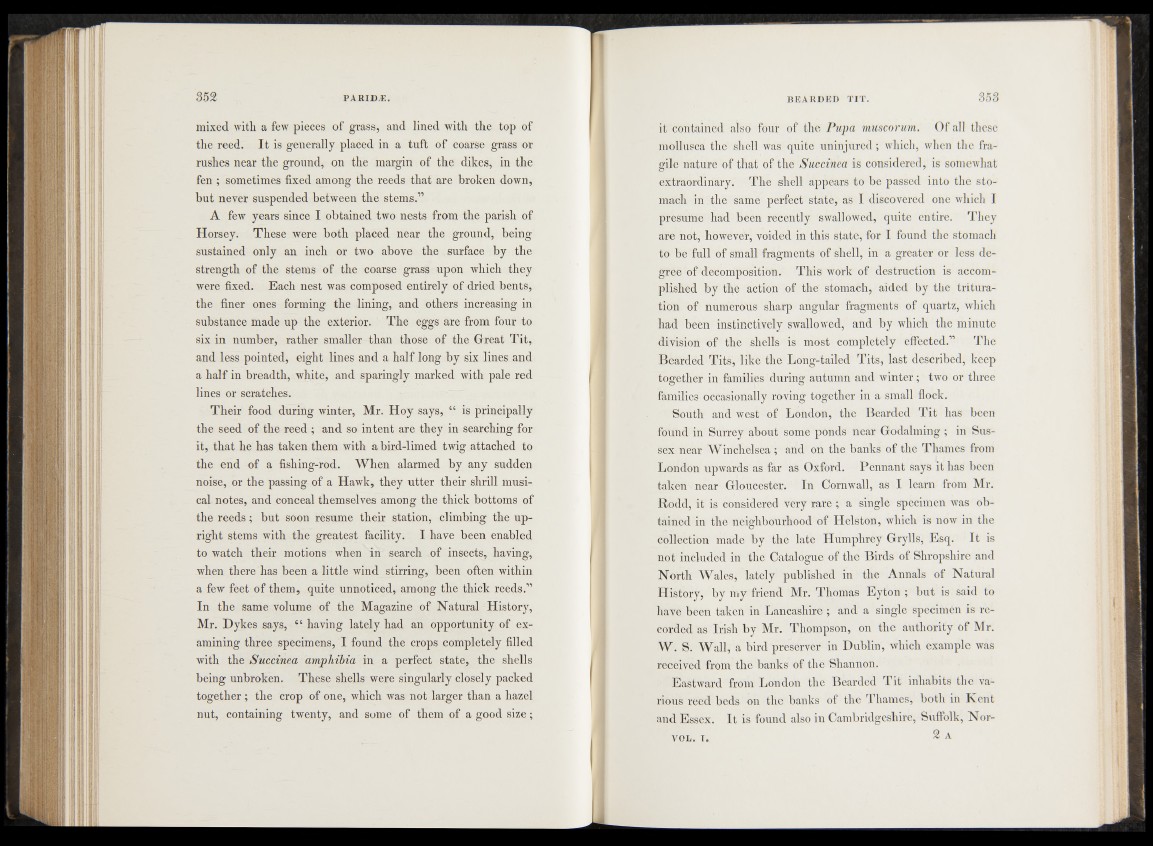
mixed with a few pieces of grass, and lined with the top of
the reed. It is generally placed in a tuft of coarse grass or
rushes near the ground, on the margin of the dikes, in the
fen ; sometimes fixed among the reeds that are broken down,
but never suspended between the stems.”
A few years since I obtained two nests from the parish of
Horsey. These were both placed near the ground, being
sustained only an inch or two above the surface by the
strength of the stems of the coarse grass upon which they
were fixed. Each nest was composed entirely of dried bents,
the finer ones forming the lining, and others increasing in
substance made up the exterior. The eggs are from four to
six in number, rather smaller than those of the Great Tit,
and less pointed, eight lines and a half long by six lines and
a half in breadth, white, and sparingly marked with pale red
lines or scratches.
Their food during winter, Mr. Hoy says, “ is principally
the seed of the reed ; and so intent are they in searching for
it, that he has taken them with a bird-limed twig attached to
the end of a fishing-rod. When alarmed by any sudden
noise, or the passing of a Hawk, they utter their shrill musical
notes, and conceal themselves among the thick bottoms of
the reeds; but soon resume their station, climbing the upright
stems with the greatest facility. I have been enabled
to watch their motions when in search of insects, having,
when there has been a little wind stirring, been often within
a few feet of them, quite unnoticed, among the thick reeds.”
In the same volume of the Magazine of Natural History,
Mr. Dykes says, “ having lately had an opportunity of examining
three specimens, I found the crops completely filled
with the Succinea amphibia in a perfect state, the shells
being unbroken. These shells were singularly closely packed
together; the crop of one, which was not larger than a hazel
nut, containing twenty, and some of them of a good size;
it contained also four of the Pupa muscorum. Of all these
mollusca the shell was quite uninjured; which, when the fragile
nature of that of the Succinea is considered, is somewhat
extraordinary. The shell appears to be passed into the stomach
in the same perfect state, as I discovered one which I
presume had been recently swallowed, quite entire. They
are not, however, voided in this state, for I found the stomach
to be full of small fragments of shell, in a greater or less degree
of decomposition. This work of destruction is accomplished
by the action of the stomach, aided by the trituration
of numerous sharp angular fragments of quartz, which
had been instinctively swallowed, and by which the minute
division of the shells is most completely effected.” The
Bearded Tits, like the Long-tailed Tits, last described, keep
together in families during autumn and winter; two or three
families occasionally roving together in a small flock.
South and west of London, the Bearded Tit has been
found in Surrey about some ponds near Godaiming; in Sussex
near Winchelsea ; and on the banks of the Thames from
London upwards as far as Oxford. Pennant says it has been
taken near Gloucester. In Cornwall, as I learn from Mr.
Rodd, it is considered very rare ; a single specimen was obtained
in the neighbourhood of Helston, which is now in the
collection made by the late Humphrey Grylls, Esq. It is
not included in the Catalogue of the Birds of Shropshire and
North Wales, lately published in the Annals of Natural
History, by my friend Mr. Thomas Eyton ; but is said to
have been taken in Lancashire ; and a single specimen is recorded
as Irish by Mr. Thompson, on the authority of Mr.
W. S. Wall, a bird preserver in Dublin, which example was
received from the banks of the Shannon.
Eastward from London the Bearded Tit inhabits the various
reed beds on the banks of the Thames, both in Kent
and Essex. It is found also in Cambridgeshire, Suffolk, Nor-
VOL . T. 2 A